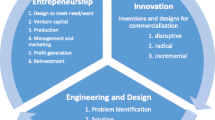Abstract
The current state of the Russian engineering industry is analyzed. Pathways for innovative development are noted.
Similar content being viewed by others
Avoid common mistakes on your manuscript.
The current global economic and industrial crisis may be traced to economic and political factors and also to the destructive effects of the COVID-19 pandemic, which has aggravated existing economic problems, disrupted supply chains, and generated a shortage of microcircuits for the production of computers and high-tech equipment.
These factors have affected the Russian engineering industry, traditionally a source of economic innovation in Russia. Products of this sector include trucks and cars, airplanes, power systems, machine tools, and industrial machinery. In the Fourth Industrial Revolution, The engineering industry is critical to Russia’s market position as a source of innovative products.
In the present work, we analyze the current state of the Russian engineering industry and identify pathways for its innovative development in unfavorable economic conditions [1–6]. First, we consider the recent development of the sector (Fig. 1).
The development of the engineering industry over the past year has been extremely uneven. Overall, output declined in the second and third quarters of 2020, when national quarantines associated with the pandemic were most severe. In the second quarter, the dynamic index fell to −18.3. This was followed by a rise to low positive values: 1.4 in the third quarter and 5.6 in the fourth quarter. In January 2021, the index fell to 3.8.
As already noted, the engineering industry is vital to the Russian economy. Its contribution to total Russian industrial output has been estimated at around 6%. In addition, this sector accounts for a larger share of the gross domestic product (GDP) than any other. However, serious problems obstruct its development (Fig. 2).
We now consider these problems in turn.
(1) Poor condition of the existing equipment. In practice, worn equipment means low efficiency, poor compliance with machining tolerances, and frequent faults and failures, with accompanying downtime and repair costs.
The solution is to modernize the existing stock of machine tools and machining centers and organize effective maintenance schedules. Note that modernization of production equipment is a key aspect of innovative development, since it improves output and product quality [1, 2].
(2) Insufficient automation of production. Like the modernization of equipment, the introduction of automated control systems in recent decades must be regarded as an essential aspect of innovative development [3]. Such systems permit radical improvement in production efficiency, automation of laborious routine functions previously performed by staff, and also increase in output and in product quality. In addition, such systems lay the basis for the digital transformation of the enterprise and the creation of a digital infrastructure [4, 5].
(3) Shortage of highly qualified staff. In our view, the remedy is the collaboration of industry and universities in organizing targeted training programs and also active recruitment of engineers by industrial enterprises. The curricula should be developed jointly by middle management at the enterprise and experienced university specialists so as to cover the competencies required in a specific shop or subdivision of the enterprise.
(4) Wasteful energy use. Such inefficiency is largely due to the poor condition of the equipment. In addition, enterprises completely lack energy-conservation policies, as a rule. In the long term, a systems approach to improving energy efficiency will result in energy conservation. One option is energy management, an interconnected set of organizational measures and energy-saving technologies.
Adoption of energy management implies the introduction of energy-saving technologies in most production processes at the enterprise. In addition, management is able to monitor and assess the current indices of energy conservation and energy efficiency, within individual shops and subdivisions and over the enterprise as a whole [6].
CONCLUSIONS
We have considered the main problems hindering the development of Russia’s engineering industry and outlined pathways to innovative development of the sector. In the light of the current economic and industrial crisis, the resolution of these problems will depend on state funding and also the participation of private and state investment companies. In our view, such measures will permit dynamic development of the engineering industry, setting the stage for the digital transformation of its enterprises.
REFERENCES
Goodfellow, I., Benjio, Y., and Courville, A., Deep Learning, Cambridge, Massachusetts: MIT Press, 2016.
Golov, R.S., Conceptual foundations of the management of innovation and investment activities of the organization, Ekon. Upr. Mashinostr., 2009, no. 3, pp. 36–43.
Golov, R.S. and Myl’nik, A.V., The organization of relay networks as an objective necessity in the development of innovative systems, Ekon. Upr. Mashinostr., 2010, no. 3, pp. 10–17.
Zhuze, V.B., Golov, R.S., and Teplyshev, V.Yu., Kon-tseptual’nye osnovy innovatsionnogo razvitiya i moder-nizatsii sistemy munitsipal’nogo teplosnabzheniya (Conceptual Basis of Innovative Development and Modernization of the Municipal Heat Supply System), Moscow: Ukhta, 2007.
Kleiner, G.B., Korablev, Yu.A., and Shchepetova, S.E., Human in the digital economy, Ekon. Nauka Sovr. Rossii, 2018, no. 2 (81), pp. 169–175.
Serebryakova, N.A. and Petrikov, A.V., The principles of design and the organization of functioning of innovative infrastructures in the conditions of the Industry 4.0, Vestn. Voronezh. Gos. Univ. Inzh. Tekh., 2018, vol. 80, no. 4 (78), pp. 384–387.
Author information
Authors and Affiliations
Corresponding authors
Additional information
Translated by B. Gilbert
About this article
Cite this article
Myl’nik, V.V., Golov, G.R. Innovative Development in the Russian Engineering Industry. Russ. Engin. Res. 42, 753–754 (2022). https://doi.org/10.3103/S1068798X22070218
Received:
Revised:
Accepted:
Published:
Issue Date:
DOI: https://doi.org/10.3103/S1068798X22070218






